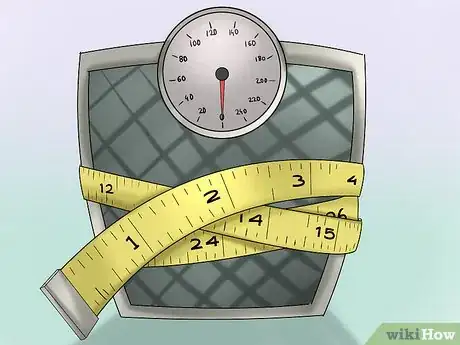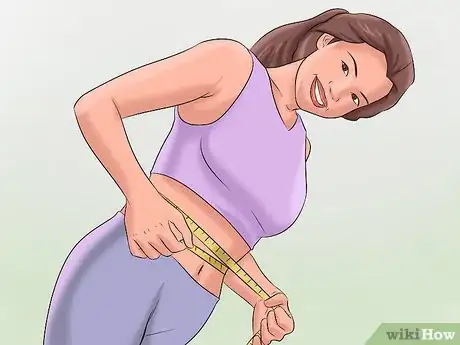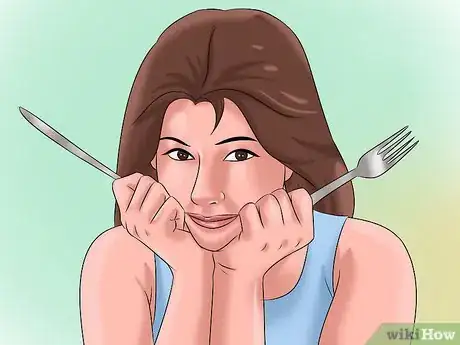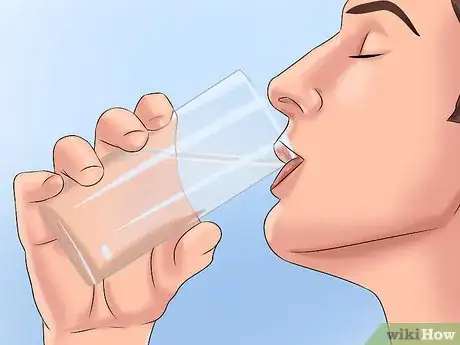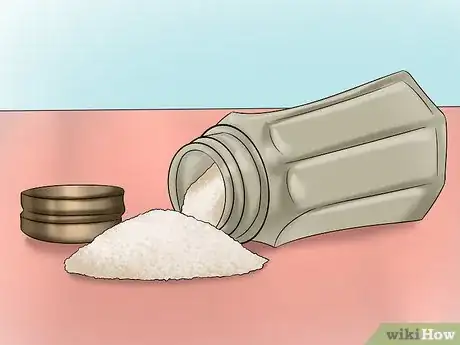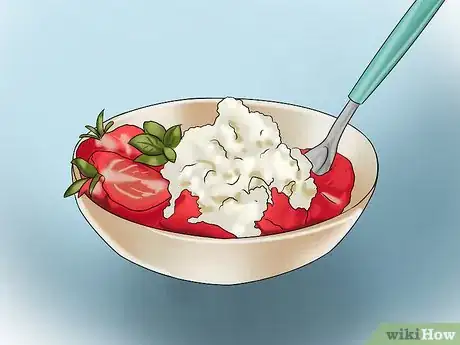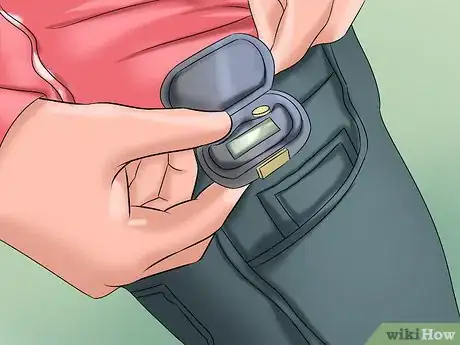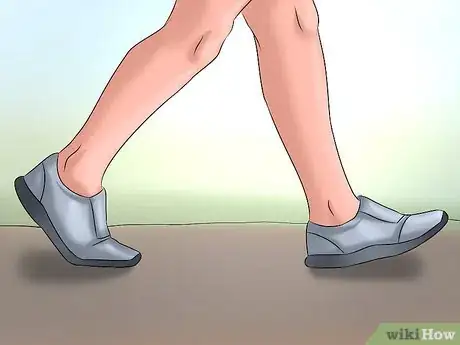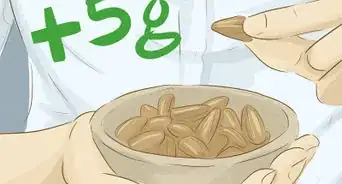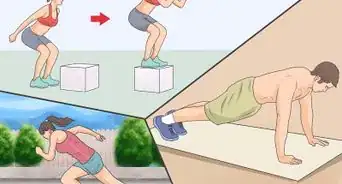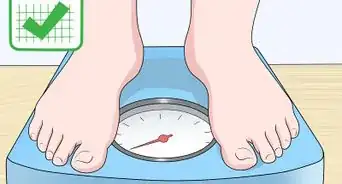This article was co-authored by Landis Owens. Landis Owens is a Personal Trainer and the Owner of Almighty Personal Training Studio in Tempe, Arizona. With over 15 years of experience in the health and fitness industry, Landis specializes in weight loss, nutrition, and core and strength training. Landis received a football scholarship to Mesa Community College where he studied Engineering and Sports and Exercise. He is an ISSA Certified Personal Trainer and also holds certifications in Nutrition, Youth Sports, Injury Stay Free, and CPR. Landis also competes in bodybuilding competitions.
There are 8 references cited in this article, which can be found at the bottom of the page.
This article has been viewed 13,174 times.
Your diet has been successful so far, but before you could drop those last 10 pounds separating you from your ideal weight, your efforts have plateaued and your scale has reached a standstill. Most dieters fall into this pattern, though, so you're not alone. There are legitimate reasons why this sort of thing happens so much, and once you learn the cause, you can set up measures to counteract it.
Steps
Part One: Doing the Mental Workout
-
1Understand the science. It isn't your imagination—those last 10 pounds really are harder to burn than the pounds you burned before them. That's because your body has a harder time losing weight the leaner it becomes.
- When you're at a heavier weight, your body uses more energy to complete various tasks, including both daily tasks and intentional exercise. As you lose weight, you actually reduce the amount of work your body must complete to accomplish the same tasks. Doing less work also means that you're burning fewer calories.
- When you lose weight, the hormones that control energy use are down-regulated, which causes a decrease in your body's overall metabolism. As a general rule, your metabolism slows down by as many as 20 calories per day for every 1 pound you lose.[1]
-
2Take another look at your caloric requirements. If you've already lost weight, you may already understand that weight loss requires you to burn more calories than you intake. Since you're burning fewer calories now than you did before, however, you'll need to make some adjustments to the intake-output ratio before you can lose those final pounds.
- Typically, most people can lose the final bit of weight without crunching these numbers as long as they make small adjustments to their dieting routine. Others may find it beneficial to understand the math.
- Since the body burns roughly 10 to 20 calories fewer for every 1 pound lost, you can use that to help calculate the difference in your metabolism by multiplying your weight loss by 10 to 20 calories.
- For example, if you started at 150 pounds and are down to 140 pounds, you've already lost about 10 pounds. This means that your body is losing 100 to 200 calories less when it performs the same activities it performed at 150 pounds.
- Under these circumstances, you'll need to burn approximately 100 to 200 calories more each day to lose weight at the same rate as before.
Advertisement -
3Review your baseline daily calorie limit. If you've never actually calculated how many calories you should consume each day, it might be helpful to do so now.
- These numbers are based on age, activity level, and the median BMI for men (22.5) and women (21.5) at a healthy weight.
- If your BMI is between 18.5 and 24.9, this information should be fairly accurate. If your BMI is above this range, however, these estimates might actually be somewhat lower than necessary. Note that if you don't know your current BMI, you can calculate your BMI by looking at a standard height/weight BMI chart.[2]
- These numbers also apply most accurately to people who are moderately active. If you're very active, you'll need to consume 200 to 400 calories more. If you're sedentary, you'll need to consume approximately 200 calories less.
- To lose roughly 1 pound per week, your daily caloric intake should be:[3]
- Women, ages 19 to 30: 2000 to 2200 calories
- Women, ages 31 to 50: 2000 calories
- Women, ages 51 and older: 1800 calories
- Men, ages 19 to 30: 2600 to 2800 calories
- Men, ages 31 to 50: 2400 to 2600 calories
- Men, ages 51 and older: 2200 to 2400 calories
- These numbers are based on age, activity level, and the median BMI for men (22.5) and women (21.5) at a healthy weight.
-
4Be more vigilant. As you shed pounds and get closer to your ideal weight, it's easy to let your guard down and become more relaxed about your diet and exercise plan. Since losing weight is more difficult during this time, though, you should actually become more vigilant and intentional than before.
- Stay accountable by keeping a food diary or using a calorie-counting app. Record the things you eat and the exercises you perform, along with the estimated number of calories you consume versus calories you burn. Be as honest and accurate as possible.
Part Two: Tweaking Your Calorie Intake
-
1Let yourself get hungry. Instead of eating before you feel hunger, try to let a little hunger develop before grabbing any food. Doing so will ensure that you don't eat more often than your body actually needs.[4]
- Additionally, train your body to eat every three to four hours. This includes both meals and snacks. When it's time to eat, make sure you're legitimately hungry and not just bored or thirsty.
- Take your time while eating so that your body can begin digesting the food. Doing so will help you fill up on less. As a general rule, you should also eat until you're only about 80 percent full—not 100 percent stuffed—and avoid finishing everything on your plate if you don't feel hungry for it.
-
2Adjust your nutrient ratios. Low-calorie diets are more effective than other diet trends, but some people do have sensitivities to carbohydrates and dietary fats that can make weight loss difficult. Consider adjusting your diet so that you consume more protein and fewer carbohydrates.[5]
- Most of the extra protein you consume should come from non-meat sources, however. Meat introduces more unhealthy fats and calories into your diet, so it can hinder your weight loss efforts when consumed in excess.
- Instead of eating more meat, try eating things like nuts, lentil soup, chickpeas, whole wheat pastas, and vegetables.
-
3Consume more dietary fiber. Fiber cleanses your digestive system and helps reduce visceral fat around the abdomen, which also reduces your risk for health concerns like high blood pressure and diabetes.
- You can get more fiber through food sources or dietary supplements. Good food sources include beans, vegetables, fruits, and seeds. Either way, try to get 21 to 38 grams of fiber each day.
-
4Drink more water. Regardless of how much water you're currently drinking, you should try to increase the total amount to about 80 oz or 10 cups (2.5 L) each day.[6]
- Drink the majority of your water and other fluids immediately before or during a meal to maximize the benefit. Drinking two glasses with a meal will help fill your stomach and may make it easier to consume 75 to 90 calories less.
- Remember—your body is about 90% water, so you need to drink a lot.[7]
- Water gives you alertness, awareness, competence, better focus, and constant energy.[8]
-
5Reduce sodium intake. Watch your sodium intake carefully. Salt forces your body to retain fluids, which will increase your weight and make it harder to drop those 10 pounds.
- Since most foods contain some sodium, read the nutrition labels to know how much you're consuming. Be especially vigilant about breads, soups, poultry, and cured meats. Try to cut down your total sodium intake to roughly 1000 mg per day.[9]
-
6Remove processed foods and alcohol from your diet. Both add empty calories to your diet. Even if you were able to enjoy them during the early stages of your weight loss, you should reduce or remove them from your diet now that your calories count more than ever.
- Processed foods include any food or drink that's been altered from its natural state. This includes most canned foods, boxed meals, and refined grains. Whenever possible, opt for fresh fruits and vegetables, lean meats, fresh dairy, and whole grains over their processed counterparts.
- Most alcoholic beverages are relatively high in calories. Moreover, alcohol promotes fat storage, decreases muscle growth, and makes you feel hungrier. Since it also affects your decision-making abilities, drinking alcohol will make it harder to resist temptation, too.
-
7Curb your hunger with low-calorie foods. Eating a low calorie snack 15 minutes before sitting down for a major meal is a good way to control your portion sizes. The snack will partially fill your stomach, making it easier to get full on less food during lunch and dinner.
- Apples are an especially good choice. They only contain 65 calories apiece on average, and as long as you eat both the peel and flesh, your body expends nearly the same amount of calories digesting it.
-
8Satisfy your body's cravings for fats and sweets. Completely cutting fats and sugars from your diet is a bad idea since it can negatively impact both your help and your morale, but you also need to be smart about how you satisfy your body's cravings for them.
- Omega-3 fatty acids are especially beneficial for your body. They make it easier for cell membranes to develop insulin receptors, which then allows your body to lower its insulin levels. Lower insulin means less abdominal fat. One fish oil capsule and one 3-oz (85-g) serving of fatty fish provides roughly the same amount of omega-3.
- Other sources of healthy fats and oils include nuts, seeds, and avocados.
- If you have a notorious sweet tooth, consider appeasing it with a protein-rich, low-calorie sweet. Options include a single scoop of light ice cream, a single serving size carton of low-fat yogurt with fresh fruit, or a glass of low-fat chocolate milk.
Part Three: Adjusting Your Calorie Output
-
1Sleep more. Poor sleep decreases your metabolism, so sleeping better will make it easier for you to burn calories. Aim for eight hours of sleep each night.
- Lack of sleep also stimulates the appetite and increases the rate at which you lose lean muscle tissue.
- Intentionally set aside at least eight hours for sleep each night, and try to fall asleep and wake up at the same time each day. If you have difficulty sleeping, you may need to research techniques to improve the amount and quality of sleep you get each night.
-
2Spend more time on your feet. Standing burns more calories than sitting. No matter what your life is like, try to replace one hour of sitting with one hour of standing throughout the course of each day.
- Making this switch can burn an extra 100 calories, which can help offset the drop in your metabolism caused by your current amount of weight loss.
-
3Count your steps. Wear a pedometer to keep track of how many steps you take each day. Walking more often will burn more calories, and counting your steps will let you know how much walking you actually do.
- Wear the pedometer and walk your usual amount for at least three to four days. Once you figure out your average number of steps, you can set goals for increasing that amount.
- Start by getting an extra 2000 steps each day. After several days of adjusting to that amount, increase your steps by a similar interval. Continue along in this manner until you're walking roughly 10,000 steps on a daily basis.
-
4Practice interval training. Interval training is the practice of mixing short bursts of intense exercise into moderate exercise routines. When done right, it can boost your metabolism and allow you to burn more calories during low and moderate levels of activity.
- During any cardiovascular exercise you perform (jogging, swimming, cycling, etc.), switch back and forth between moderate effort and vigorous effort.
- For example, try running for 5 minutes after jogging for 10 minutes. Reduce your speed back down to a jog for another 10 minutes, then finish up with another 5 minutes of running.
- A 30-minute interval workout can help you burn 20 percent more calories than you'd expect to burn when exercising at a consistent pace.
- During any cardiovascular exercise you perform (jogging, swimming, cycling, etc.), switch back and forth between moderate effort and vigorous effort.
-
5Increase the exercise you already perform. If you already perform some regular form of cardiovascular exercise, consider boosting the time spent on that exercise by 5 to 15 minutes.[10]
- The exact amount will vary based on the intensity of the exercise. For vigorous exercise, an extra 5 minutes should suffice. For gentle to mild exercise, you may need to boost the amount to 15 minutes.
- To make the biggest difference, you'll need to do this for each exercise you already perform. In other words, if you take a power walk in the morning and go for a run at night, add 15 minutes to your power walk and 5 minutes to your evening run.
-
6Include strength training into your routine. Cardiovascular exercise burns more calories in the short-term, but strength training increases your metabolism, which helps your body burn more calories in the long-term.
- Try to do an equal amount of both types when you're working on those final 10 pounds. After a month or so, you may notice your body burning up to 30 percent more calories for the exercise you do.
References
- ↑ http://www.prevention.com/weight-loss/weight-loss-tips/how-lose-last-10-pounds
- ↑ http://www.webmd.com/men/weight-loss-bmi
- ↑ http://www.webmd.com/diet/calories-chart
- ↑ http://www.huffingtonpost.ca/natasha-turner-nd/lose-weight-10-pounds_b_3534930.html
- ↑ http://www.builtlean.com/2014/01/07/lose-10-pounds-fat/
- ↑ Landis Owens. Personal Trainer. Expert Interview. 13 July 2021.
- ↑ Landis Owens. Personal Trainer. Expert Interview. 13 July 2021.
- ↑ Landis Owens. Personal Trainer. Expert Interview. 13 July 2021.
- ↑ http://www.jillianmichaels.com/fit/lose-weight/myth-vanity-pounds
About This Article
If you’re trying to lose the last 10 pounds for your ideal weight, know that it’s normal to hit a plateau here but you can overcome it. To do so, reduce your salt intake since sodium can make it harder to drop the pounds. You should also try to cut processed foods and alcohol from your diet since these are empty calories that will get in the way of your goal. If you’re already working out, up the intensity by spending 5 to 15 more minutes on each exercise. You can also add in some interval training to boost your metabolism and burn more calories. Along with eating right and exercising, aim to get 8 hours of sleep each night since poor sleep can decrease your metabolism and stimulate your appetite. For more help, including how to review your baseline daily calorie limit, read on!
